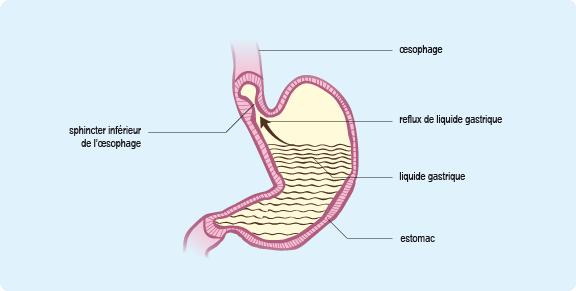
Simple regurgitation or gastroesophageal gastroesophageal?
It is enough that Bébé regurgite several times and without apparent reason so that her mother immediately worried about it with their pediatrician!What's going on, doctor?Rest assured, most of the time, gastroesophageal reflux (GERD) is physiological.These are called regurgitations or if you prefer references as our grandmothers said.Pathological gastroesophageal reflux is much rarer.Our explanations.
Physiological gastroesophageal regurgitations or gastroesophageal reflux?What is this ?
Simply the exteriorization through the mouth of the milk that your baby has just drunk.These regurgitations go back very easily from the esophagus - not to be confused with vomiting which, themselves, require muscle effort.In question: the sphincter called cardia which is at the junction of the stomach and the esophagus.It opens when the food bowl (food) arrives in the stomach and must close after their passage.But now, at birth, due to digestive immaturity, it closes badly! It's normal.
Is it common?Yes and from birth!We note that around two thirds of babies under 4 months have a gastroesophageal reflux physiological physiological.And that at the age of 6 months, there are still 5 to 6 % without it being pathological.Some adults continue to suffer from it too!
At what moment ?Regurgitations occur after the meal.Milk has not yet been digested, they are not acidic and therefore not painful.The baby remains smiling, does not cry when it goes up and its growth curve is impeccable.Everything's good !
It hurts ?No.Except when the regurgitations occur from meals remotely (1 hour later for example with a rot) or later.They can irritate.For what ?Because milk started to be digested.What goes up is acidic and burns the esophagus.His wall is not made to endure acidity, unlike that of the stomach, so it makes a bad.The baby cries.There may also be reflux without it emerging through the mouth.The milk remains in the esophagus ... and is swallowed.Neither seen nor known !This is why GERD is not so easy to diagnose.
What do I do against regurgitation or physiological gastroesophageal reflux?
At this stage of GERD, there is no recommended medical treatment (however, some doctors prescribe antisercretoires without doing any exams, read the pathological gastroesophageal reflux below).On the other hand, dietetic and hygiene rules improve the situation.

• Consult.If only to be reassured by the pediatrician!Who will confirm that there is no connection with the risk of sudden death.Your child is not likely to choke.
• Use thickened anti-regurgitation milk prescribed by the pediatrician.Thus, the milk goes up less easily in the baby esophagus.
• Fragmerate the power supply.More bottles during the day, each with less volume = less risk of regurgitation.
• Do not smoke in the house.The tobacco smoke that baby inhales when you smoke around it (= passive smoking) is not good for GERD!It irritates and relaxes the sphincter of the esophagus.
• Keep baby straightened at least half an hour after the bottle, a rot is welcome.The bad idea is to cross it very quickly.Use and abuse bib, Lange, etc., to limit the damage.
• Continue to bed on your back and flat.Admittedly, reflux decrease when it is lying on the stomach.Nevertheless, the proclive ventral position (on the belly and in decline at 30 °) has not been recommended for years.As for the proclive dorsal position (on the back and in acclimate), it has never proven its effectiveness.There is also a risk that the baby rolls at the bottom of the bed if it is badly attached.
• Do not tighten the layer too much.You have already noticed that if you are too tight in your pants after the meal, digestion is not frankly facilitated!Does it disappear?Over time, yes.Things improve a little at the time of food diversification, when food becomes solid.But the real improvement occurs between 12 and 15 months, at the age of walking.Standing "straightens" the stomach, the pressure in the abdomen is less strong ... and the maturity of the digestive system is made!No more GERD.
Pathological gastroesophageal reflux.What is this ?
The same as regurgitation but stronger.In this case, digestive immaturity is such that the sphincter is very open, even gaping.Many regurgitations go up through the mouth, sometimes through the nose.They occur at any time, from a distance from meals and during sleep too.It's painful, the baby no longer wants to drink his bottles, his weight stagnates.Obviously, the more frequent the regurgitations, the more the esophagus is damaged (inflammation is called an esophagitis), the more it hurts ... pathological rgo is accompanied by recidivizing ear (which put the chip in thepediatrician), laryngites, bronchitis, infant asthma.And more rarely, of an intolerance or an allergy to the proteins of cow's milk.
Who is affected?Especially premature children, those with neurological pathologies (polyhandicappeds for example), congenital atresia of the esophagus, significant hiatal hernias.Pathological GERD is not very common.
How do we make the diagnosis?Using a metrian pH, an examination that is done on an outpatient in the hospital.The doctor slides by the nose a very fine hose which descends into the esophagus and deposits a small case measuring acidity for 24 hours (how many times reflux, etc.).Is also prescribed a fibroscopy which allows to take samples in the esophagus.These highlight the consequences of GERD, namely the degree of esophagitis.
What are the treatments ?To reduce the acidity of the esophagus, there are only antisercretory drugs of the Mopral type.The lesions heal and disappear, but reflux is still there.This treatment has no side effects.When GERD is very important, are sometimes prescribed in second intention of pro-kinetic drugs, in hospital and under medical supervision.They accelerate gastric emptying and tone the sphincter.These drugs of the prepulsid, Primperan and Motilium type are no longer allowed in town.They have side effects, especially cardiacs.The effective dose is not far from the toxic dose.
Does it disappear?Pathological GERD spends most of the time when baby starts walking.







